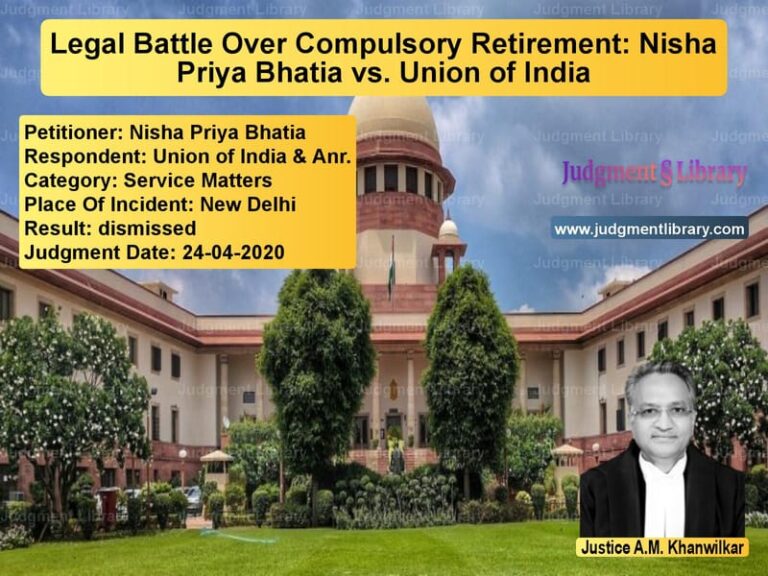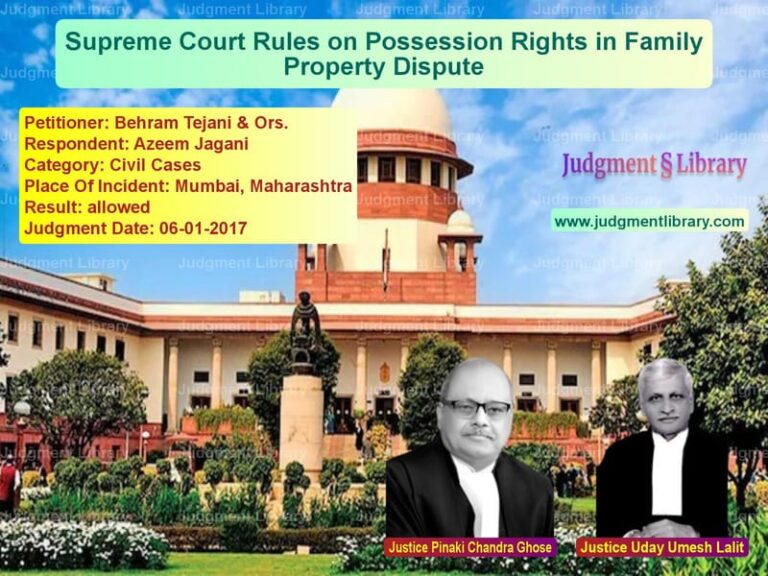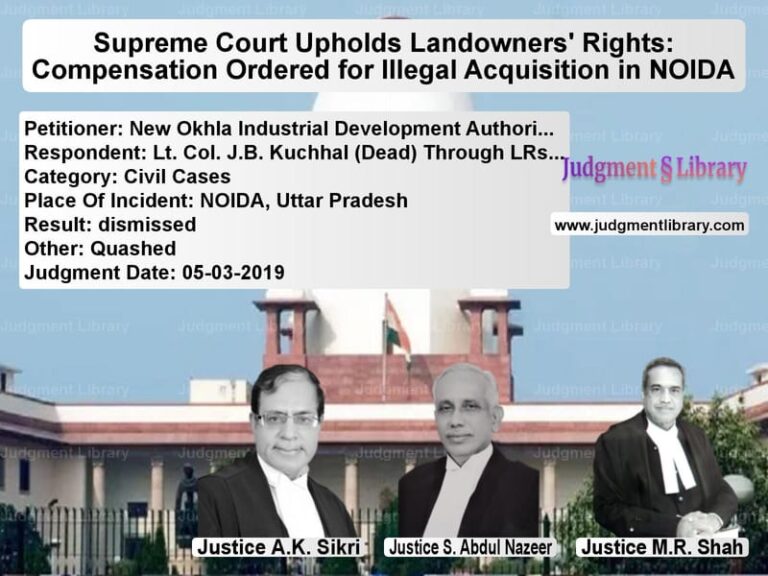XYZ v. Abhisheik & Anr.: Dispute on Juvenility and Offence Determination
The case of XYZ versus Abhisheik & Anr. centers around a critical issue of juvenility in the context of criminal charges involving gang rape and related offences. The appellant, XYZ, challenges the findings of the High Court of Madhya Pradesh, which ruled that the first respondent, Abhisheik, was a juvenile at the time of the incident, thus affecting the legal proceedings under the Juvenile Justice Act. This case revolves around the question of whether the first respondent was a juvenile during the commission of the crime, and if so, how this impacts the charges and legal consequences against him.
The events leading to the appeal stemmed from an FIR registered on July 24, 2015, based on the information provided by XYZ, the appellant, who alleged that she had been subjected to gang rape by the first respondent, Abhisheik, and others. The charges included serious criminal offences under sections 363, 366A, 376, 506, and 120B of the Indian Penal Code (IPC), as well as sections 3 and 4 of the Protection of Children from Sexual Offences (POCSO) Act. These offences were reportedly committed about three to four months before the registration of the FIR. The first respondent, during the investigation, claimed that he was a juvenile at the time of the crime, which led to the filing of an application for his juvenile status to be officially recognized.
The initial investigation into the case revealed that the first respondent presented a certificate stating his date of birth as January 30, 1999, which was based on his matriculation record. However, upon inquiry by the Judicial Magistrate First Class (JMFC), the authenticity of the certificate was questioned, and the JMFC found it to be fabricated. Subsequently, an FIR was registered against the first respondent for fabricating documents to support his claim of juvenility. The matter was then referred to the 4th Additional Sessions Judge, Satna, for an inquiry, which concluded that the first respondent was not a juvenile at the time of the incident, based on the evidence and a medical report which estimated his age to be between 17 to 21 years.
Despite the findings of the Additional Sessions Judge, the first respondent appealed to the High Court of Madhya Pradesh, arguing that he was indeed a juvenile based on the birth certificate issued by the Municipal Corporation, Satna. The High Court, upon reviewing the documents, accepted the first respondent’s claim, relying on the certificate issued by the Municipal Corporation and the school records, which indicated a date of birth of January 30, 1999. The High Court ruled that the first respondent was a juvenile at the time of the alleged offence and reversed the findings of the Sessions Court. This decision was challenged by the State of Madhya Pradesh, which argued that the documents provided by the first respondent were forged and that the medical report clearly indicated that he was not a juvenile.
The appellant, XYZ, and the State of Madhya Pradesh filed appeals against the High Court’s decision in the Supreme Court, challenging the findings of the High Court and asserting that the first respondent should not be treated as a juvenile. The central issue was whether the first respondent’s claim of juvenility could be accepted, given the evidence that suggested the documents supporting his claim were fabricated. The appellant’s counsel argued that the High Court had erred in relying on the forged birth certificate and school records, and that the first respondent’s juvenility should have been rejected. The counsel for the State emphasized that the medical report and the findings of the Sessions Judge proved that the first respondent was not a juvenile.
The Supreme Court, after considering the arguments, examined the relevant provisions of the Juvenile Justice (Care and Protection of Children) Act, 2000, along with the rules for determining the age of a juvenile. The Court reviewed the documents produced by the first respondent, including the birth certificate and school records, and noted the discrepancies and issues with the authenticity of these documents. The Court also referred to the procedures outlined under Section 7-A of the Juvenile Justice Act and Rule 12(3) of the 2007 Rules, which provide guidelines for determining the age of a juvenile.
The Court concluded that the documents provided by the first respondent could not be relied upon due to clear evidence of manipulation and forgery. The Supreme Court ruled that the High Court had erred in reversing the findings of the 4th Additional Sessions Judge and accepting the fabricated documents as proof of juvenility. The Court noted that the medical report, which placed the first respondent’s age between 17 and 21 years, was more reliable than the contested documents. The Court also referred to previous judgments that clarified the procedure for determining juvenility and held that the first respondent was not entitled to the benefits of the Juvenile Justice Act.
As a result, the Supreme Court set aside the judgment of the High Court and upheld the findings of the 4th Additional Sessions Judge, confirming that the first respondent was not a juvenile at the time of the crime. The appeals were allowed, and the matter was directed to proceed according to the law, with the first respondent facing charges as an adult. The Court also emphasized the importance of accurate and reliable documentation in cases involving juvenility claims and reiterated the need for thorough scrutiny of such claims to prevent misuse of legal provisions meant for the protection of minors.
The case highlights the complex issues surrounding the determination of juvenility and the need for credible evidence to support claims of juvenility. It underscores the importance of following proper legal procedures and verifying documents to ensure that individuals do not evade legal consequences through fraudulent claims. The judgment is a significant contribution to the jurisprudence on juvenility and the protection of children under the law.
Petitioner Name: XYZ.Respondent Name: Abhisheik & Anr..Judgment By: Justice Dr. Dhananjaya Y. Chandrachud, Justice Hima Kohli.Place Of Incident: Satna, Madhya Pradesh.Judgment Date: 02-09-2022.
Don’t miss out on the full details! Download the complete judgment in PDF format below and gain valuable insights instantly!
Download Judgment: xyz-vs-abhisheik-&-anr.-supreme-court-of-india-judgment-dated-02-09-2022.pdf
Directly Download Judgment: Directly download this Judgment
See all petitions in Murder Cases
See all petitions in Bail and Anticipatory Bail
See all petitions in Cyber Crimes
See all petitions in Juvenile Justice
See all petitions in Money Laundering Cases
See all petitions in Judgment by Dhananjaya Y Chandrachud
See all petitions in Judgment by Hima Kohli
See all petitions in allowed
See all petitions in supreme court of India judgments September 2022
See all petitions in 2022 judgments
See all posts in Criminal Cases Category
See all allowed petitions in Criminal Cases Category
See all Dismissed petitions in Criminal Cases Category
See all partially allowed petitions in Criminal Cases Category







